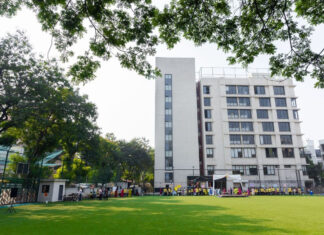YEREVAN – The idea for the American University of Armenia (AUA) was born in the winter of 1989, a few months after the devastating Spitak earthquake. After this tragedy, Dr. Armen Der Kiureghian of the University of California (UC), Berkeley, and Dr. Yuri Sargsyan, then Rector of the Yerevan Polytechnic Institute in Armenia, began a conversation which eventually led to a proposal by Der Kiureghian and Dr. Mihran Agbabian of the University of Southern California to establish a western-style university in Armenia. Dr. Stepan Karamardian, the Dean of Business at UC Riverside, soon joined the team. With a partnership with the University of California and a funding commitment by Louise Manoogian Simone, then president of the Armenian General Benevolent Union (AGBU), AUA was established. “An interesting fact about AUA is that it is as old as the Republic of Armenia, as it opened its doors on September 21, 1991, the same day Armenia declared independence from the former Soviet Union,” remarked Der Kiureghian.
Twenty-eight years later, AUA’s co-founder, who has been serving as president for the past five years, is passing the baton. Der Kiureghian also has held a variety of positions at AUA, including founding dean of the College of Engineering and Interim Provost.
Der Kiureghian believes the University has accomplished much beyond the initial aspirations. “We started the University at a very difficult time in Armenia. There were the lingering effects of the earthquake, an ongoing war, and severe shortages of basic necessities, but we persevered. Today, many of our graduates hold government positions all the way from ministers to regional governors. They are instructors and professors teaching in various universities, including AUA. There are great examples of successful startups, like PicsArt and gg-Taxi, that are founded by our graduates. They work in banking, businesses, NGOs, government agencies, and educational institutions in Armenia and elsewhere. We have an increasing number of supporters and generous philanthropists so, in many ways, the dream has been realized. The question now is how we grow the University so it can have even greater impact in Armenia.”
That is the question that incoming president Dr. Karin Markides also has on her mind. Having gone through a thorough recruiting process, she was one of the four finalists from a pool of 60 candidates for the position.
“I’m very much about how we work to make impact in a sustainable and collaborative way by first building trust among key stakeholders and then incentivizing an evolutionary process. Through my previous work as President of Chalmers University of Technology in Sweden, one of the main things we accomplished was breaking down silos by creating cross-collaboration among strong departments, excellent faculty, talented students, and dedicated external collaborators, creating open environments where complex challenges could be handled and innovation could happen. This is a method I believe that all institutions, whether governmental, business or academic, would benefit from.”
With an impressive resume that includes lecturing at Stanford University as a guest professor, Markides completed her doctorate at Stockholm University in 1984, after which she started her research career at Brigham Young University in Utah as a postdoctoral fellow then as a research assistant and associate director. In May 1990, she returned to Sweden as a chair and dean of Chemistry and Chemical Engineering at Uppsala University. Fourteen years later, in May 2004, she became vice director general of Vinnova, the Swedish innovation agency. Subsequently, Markides was selected as president of Chalmers University of Technology and, since 2015, she serves as the Chair of the Scientific Council for Sustainable Development under the Swedish government.








